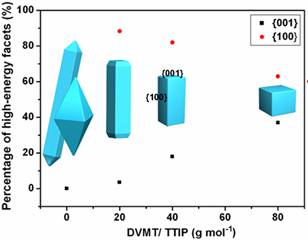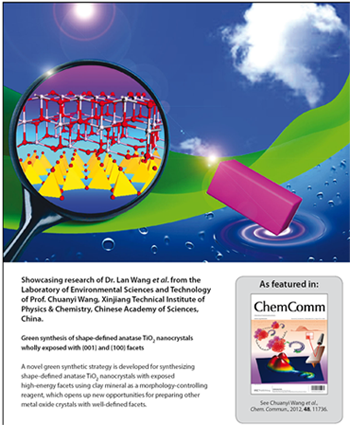Titanium dioxide (TiO2), as one of the most promising semiconductor materials, has become a topic of intensive study due to its important applications in a broad range of fields. However,the physicochemical properties of TiO2 (one of the most studied metal oxides for its many important applications) largely depend on the exposed crystal facets. In this scenario, many efforts have been directed to engineering the morphology of TiO2 with specifically exposed crystal facets.
Dr. WANG Lan and colleagues from the Laboratory of Environmental Sciences and Technology, Xinjiang Technical Institute of Physics & Chemistry, Chinese Academy of Sciences(XTIPC), found a novel, environmentally benign synthetic strategy for shape-defined anatase TiO2 nanocrystals wholly exposed with {001} and {100} facets.
 |
| Figure1. Relationship between the percentage of high-energy facets and the ratio of DVMT/TTIP (insets are schematic models of anatase TiO2for the different ratios of DVMT/TTIP). |
Titanium isopropoxide (TTIP) is used as the TiO2 precursor, tetramethylammonium hydroxide (Me4NOH) as a dual-functional reagent,and low cost acid-delaminated vermiculite (DVMT) as the hard template controlling the morphology and growth of the crystal facets. Combined optimization of such a reaction system leads to the formation of well-faceted anatase TiO2 nanocrystals, for which the morphology and size of TiO2 crystals can be controlled simply by adjusting the ratio of DVMT to TTIP in the hydrothermal reaction system. With increasing DVMT content, the ‘‘hard template’’ effects are gradually enhanced, leading to the transformation from elongated nanorods to cube-like anatase TiO2 particles (Figure 1).
These results reveal that the DVMT layers act as effective hard template selectively stabilizing the {001} facets of TiO2. The present synthesis represents a green approach as no fluorine-containing reagents are involved, avoiding the environmental problems from F- ions. This is the first report of using a natural clay mineral for controlled synthesis of well shape-defined TiO2 crystals with exposed high-energy facets, and the synthetic strategy is adoptable to other metal oxides.
The work was published on Chem. Commun.,2012,48:11736-11738,and was highlighted on the back cover of Chem. Commun (Figure 2) .This research work was financially supported by National Natural Science Foundation of China and “One Hundred Talents” program of Chinese Academy of Sciences.

Figure 2. The back cover of Chem. Commun.
For details,please contact:
Prof. WANG Chuanyi
E-mail:cywang@ms.xjb.ac.cn
